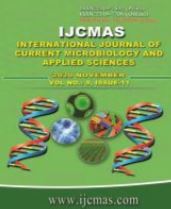


 National Academy of Agricultural Sciences (NAAS)
National Academy of Agricultural Sciences (NAAS)

|
PRINT ISSN : 2319-7692
Online ISSN : 2319-7706 Issues : 12 per year Publisher : Excellent Publishers Email : editorijcmas@gmail.com / submit@ijcmas.com Editor-in-chief: Dr.M.Prakash Index Copernicus ICV 2018: 95.39 NAAS RATING 2020: 5.38 |
The present investigation on the standardization of propagation techniques in Manila tamarind (Pithecellobium dulce (Roxb.) Benth.) was conducted at the Department of Fruit Science, Horticultural College and Research Institute, Periyakulam. This study includes three different propagation methods, i.e. hardwood cuttings, softwood grafting and patch budding at six different time of propagation, viz., 15thJuly, 15thAugust, 15thSeptember, 15thOctober,15thNovember and 15thDecemberduring the year 2019-2020. The results of this present study generally indicated that both the main and interaction effects of propagation methods with time of propagation had a significant influence on number of days taken to first sprouting, number of leaves and shoots/plant, fresh and dry weight of leaves, leaf area (cm2), chlorophyll content (mg/g), phenol content (mg/g), success and survival percentage of manila tamarind under mist chamber condition. The experimental results revealed that among the three propagation methods evaluated, softwood grafting performed well on 15th July which recorded the highest success percentage (97.33 %), survival percentage (92.99 %) after 90 days of propagation and also observed maximum number of leaves (178.46) and shoots per plant (13.17). In addition, chlorophyll content was higher on 15th August of softwood grafting (0.80 mg/g) while the hardwood cuttings planted on 15th July was registered the earlier sprouting (6.56 days).
 |
 |
 |
 |
 |